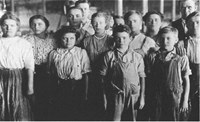- Lesson Plan (12)
- Distance Learning (4)
- Field Trips (1)
- Student Activities (1)
- Social Studies (16)
- Literacy and Language Arts (3)
- Science (3)
Showing 18 results for mill ...
Manufacturing with Marbles at Ashton Mill
Women and Children in the Mill Village
- Type: Lesson Plan
- Grade Levels: Upper Elementary: Third Grade through Fifth Grade
Mining Unit: Discovering a Stamp Mill
- Type: Lesson Plan
- Grade Levels: Upper Elementary: Third Grade through Fifth Grade

This lesson is part of a cross-curricular mining unit focused on the impacts of miners on the Death Valley community and environment. This is the introductory lesson which provides students journal writing opportunities to explore their meaning of discovery. Students will watch a short online video on mining in Death Valley and actively sequence the steps of a typical stamp mill.
The Rhode Island System of Mill Villages
- Type: Lesson Plan
- Grade Levels: Upper Elementary: Third Grade through Fifth Grade
Learning about Mill Workers through Primary Sources
- Type: Lesson Plan
- Grade Levels: Upper Elementary: Third Grade through Fifth Grade
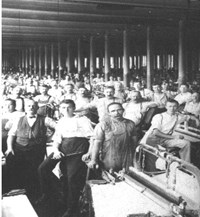
In this lesson, students will examine primary resource documents of mill workers at the Lonsdale Company in 1942. Though these are injury reports, students can get a glimpse into who was working at the mills and what types of jobs they had. Students will compare primary sources to determine similarities and differences among this sample of mill workers.
Great Smoky Mountains - Mingus Mill History and Culture
- Type: Field Trips
- Grade Levels: Lower Elementary: Pre-Kindergarten through Second Grade

The Great Smoky Mountains are world renowned for their diversity of plant and animal species. Mingus Mill, located in the Oconaluftee Valley, provides a beautiful spot where students are introduced to daily life routines of the 19th century. Through games, activities, a peek inside the operating mill, and a short hike students are encouraged to compare and contrast the communities of early settlers to their own.
Mill Girls: Life and Work in an Industrial City Virtual Field Trip
- Type: Distance Learning
- Grade Levels: Upper Elementary: Third Grade through Fifth Grade

Follow the journey of a mill girl from her family farm in the New England countryside to her new job operating a loom in Lowell’s Boott Cotton Mills. Students will meet two mill girls during their virtual visit to the boardinghouse and weave room, learning about each girl's unique experience of life and work in a textile mill, and experience for themselves a bit of what it was like to work in the mills.
- Type: Lesson Plan
- Grade Levels: Middle School: Sixth Grade through Eighth Grade
Learn about the Boott Cotton Mills complex in Massachusetts, which contains mills built from the mid-1830s to the early 20th century.
- Type: Student Activities
- Grade Levels: Upper Elementary: Third Grade through Fifth Grade

Students will understand that the Blackstone River Valley experienced a unique form of rural industrialization called the “Rhode Island System of Manufacture” after Samuel Slater built the first textile mill in Pawtucket in 1790. Early mill villages, as typified by Ashton Village between 1810 and 1870, included essential components which led to their success and proliferation in rural towns along the Blackstone River Valley.
Engineering a Better Future Virtual Field Trip
- Type: Distance Learning
- Grade Levels: Upper Elementary: Third Grade through Fifth Grade

Crushed fingers, broken legs, cuts and bruises … these were just some of the injuries suffered by 19th-century mill workers as they operated large, dangerous machines. Students will examine the Boott Cotton Mills’ looms and apply the engineering design process to identify safety problems and propose possible solutions. Using breakout groups and collaboration technology, students will design a safer loom by applying modern solutions to a historical problem.
Looming and Learning: Threading the Past and Present
- Type: Lesson Plan
- Grade Levels: Middle School: Sixth Grade through Eighth Grade
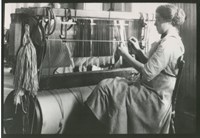
How many clothes do you own? Are any of them handmade? Why don't people tend to hand make their clothing at home anymore? This lesson will investigate our complicated relationship with something as simple as thread. Old Slater Mill was the first successful water-powered cotton spinning mill in North America. This place transformed the relationship US citizens had with their clothing. This hands-on activity investigates how our relationship with clothing has changed over the past 230 years.
A Soldier's Notes From Michigan's Big Battle
- Type: Lesson Plan
- Grade Levels: Middle School: Sixth Grade through Eighth Grade

Territory during the War of 1812 in Monroe, MI. This lesson will explore maps and primary sources to understand the significance of the battlefields. By the end of the lesson, students will be able to answer the question: Why should River Raisin and other War of 1812 battlefields be preserved and protected?
Samuel Slater: American Hero or English Traitor
- Type: Lesson Plan
- Grade Levels: High School: Ninth Grade through Twelfth Grade
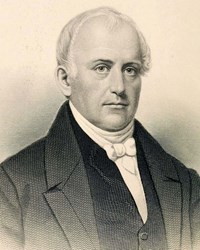
Samuel Slater is regarded as a traitor in his hometown of Belper, England. In the United States, Slater has been hailed as a hero (to some) and as the “father of American industry.” This lesson plan serves as an accompaniment to episode one of the documentary series called Slatersville: America’s First Mill Village.
Waterpower: Powering a Revolution Virtual Field Trip
- Type: Distance Learning
- Grade Levels: Middle School: Sixth Grade through Eighth Grade

Explore how Lowell's many integrated systems, including waterwheels and turbines, transformed the potential energy of the Merrimack River into kinetic energy that ran the machines. Through a series of investigations led by one of our educators, students generate hypotheses and analyze data to determine the most efficient ways to distribute energy to all the mills' machines.
Culture and Community
- Type: Lesson Plan
- Grade Levels: Upper Elementary: Third Grade through Fifth Grade
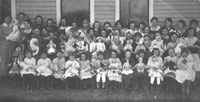
In this lesson, students will look at reasons why people immigrate and settle in new places and how that is oftentimes connected to the need for jobs. Students will choose an ethnic community whose members either came to work in and around Rhode Island mills (or a modern-day culture in their town) and create a poster honoring that community's impact using Adobe Spark (if looking for a digital option) or on a piece of paper (if looking for a hands-on option).
The Works of Faith: The Hunt Family Legacy
- Type: Distance Learning
- Grade Levels: Upper Elementary: Third Grade through Fifth Grade

When Richard Hunt first came to Waterloo, NY in 1821, he found a boom town. He and his second wife, Jane, were closely associated with local Quaker families, and intimately engaged in local business ventures. Through their faith and their industry they effected change in the community, and beyond. Explore their works--from the Underground Railroad to their woolen mill, to the tea party that set off a rebellion.
Farm to Factory Production: Making a Grilled Cheese Sandwich
- Type: Lesson Plan
- Grade Levels: Upper Elementary: Third Grade through Fifth Grade
Students will compare making a sandwich on a farm before the Industrial Revolution and today to understand the changes that have occurred over the last 200 years. Students should understand that 200 years ago on New England farms people had to make what they needed by hand. Many products readily available to us today were not available back then.


